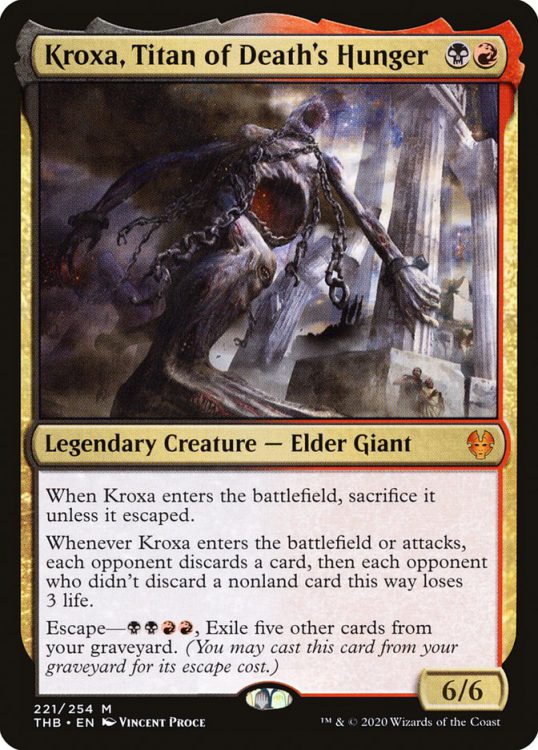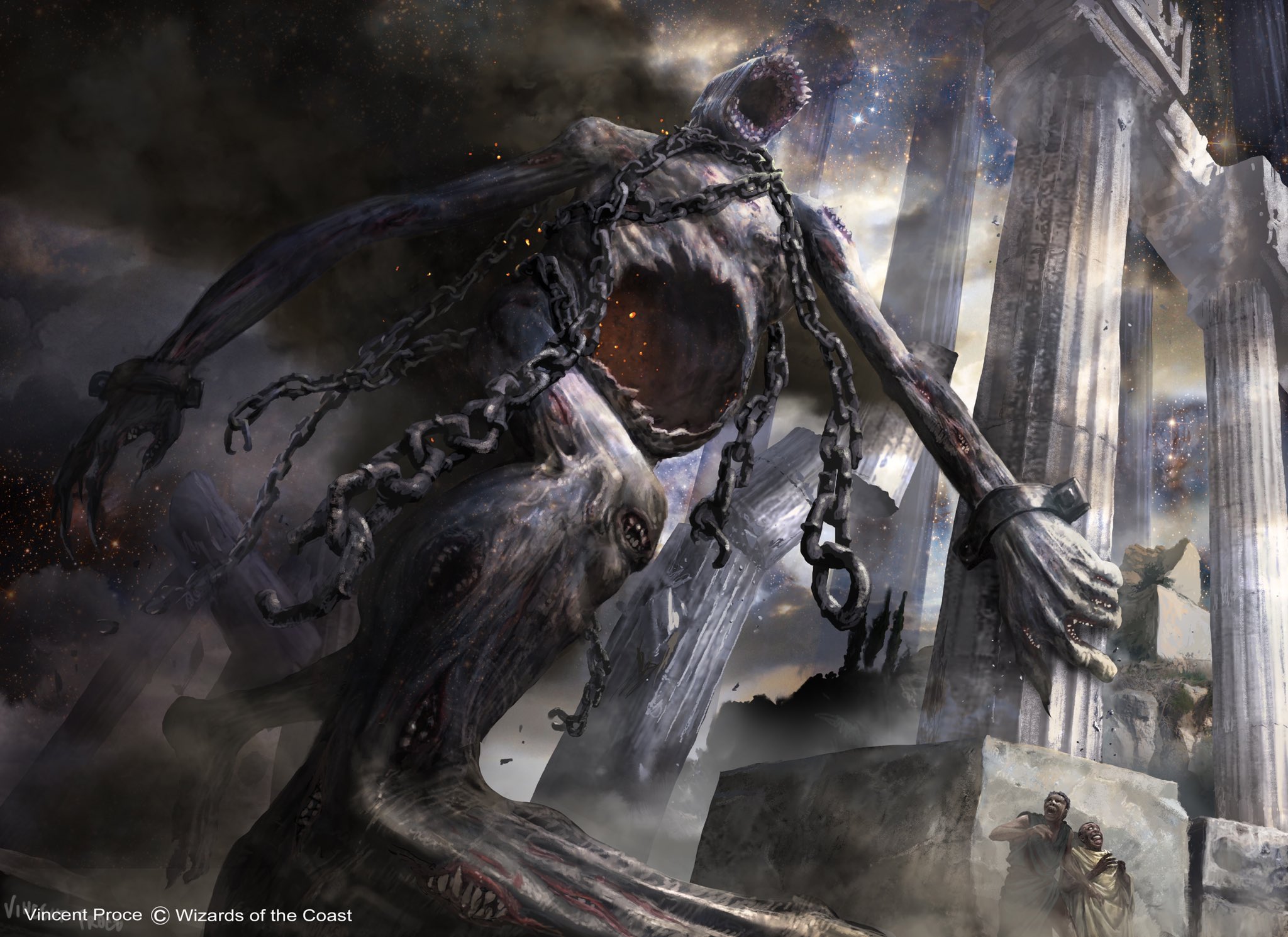Credit: Wizards of the Coast, Vincent Proce
There are a few cards in magic that have mechanics associated with them that essentially break the game. The way some of these cards are dealt with changes over time; sometimes they work one way, sometimes another. Both Morph and Ninjitsu are these odd sorts of abilities, where creatures essentially turn into other creatures. Ninjitsu in particular returns a creature to your hand as a cost [CR 702.48. Ninjutsu].
- 702.48a Ninjutsu is an activated ability that functions only while the card with ninjutsu is in a player’s hand. “Ninjutsu [cost]” means “[Cost], Reveal this card from your hand, Return an unblocked attacking creature you control to its owner’s hand: Put this card onto the battlefield from your hand tapped and attacking.”
- 702.48b The card with ninjutsu remains revealed from the time the ability is announced until the ability leaves the stack.
- 702.48c A ninjutsu ability may be activated only while a creature on the battlefield is unblocked (see rule 509.1h). The creature with ninjutsu is put onto the battlefield unblocked. It will be attacking the same player or planeswalker as the creature that was returned to its owner’s hand.
- 702.48d Commander ninjutsu is a variant of the ninjutsu ability that also functions while the card with commander ninjutsu is in the command zone. “Commander ninjutsu [cost]” means “[Cost], Reveal this card from your hand or from the command zone, Return an unblocked attacking creature you control to its owner’s hand: Put this card onto the battlefield tapped and attacking.”
In practical terms, this means you can vanish creatures up into your hand to avoid targeted spells, then a brand new creature will enter the battlefield (triggering etb effects) and then the first spell or ability added to the stack, which was being avoided, will resolve with no target and fizzle. Illusionary mask is essentially the morph ability, and is credited as the precursor to it. Raging River is sort of bizarre, let alone the horror that is the Banding keyword ability. There are also the variety of “take another players turn for them” cards which are unpleasant, and a personal favorite, Word of Command, which rather than allowing you to take another player’s turn for them allows you to cast one spell. Sorrow’s Path lets you swap two of your opponent’s blocking creatures, albeit at a high cost, creating some wonderful mismatches.
Miracle easily falls into this keyword nightmare, because you essentially draw the card, but while drawing the card look at it, and before it goes to your hand reveal it, but in Magic terms this generally happens at the same time, rather than as a sequence of events, leading to a need for a sort of draw mini-phase.
Then there is aeon engine, which just reverses the turn order, which is annoying.
Sundial of the Infinite ends the turn. Right then. When it resolves, anything “beneath it” on the stack, i.e. added to the stack before the effects, gets exiled as part of Sundial of the Infinite‘s resolution. Including things that cause sacrifices, etb effects, cards that make you lose the game or practically anything.
Enter Kroxa, Titan of Death’s Hunger:

Kroxa makes players discard, and if they don’t discard a non-land they lose 3 life. Right away, as a commander, Kroxa breaks parity very nicely. Even if you have to sacrifice him, you cause each of your opponents to discard a card, 1:3. And it’s only 2 mana.
But truth be told Rakdos is in a tough spot. Black has strong spot removal (ugh) and red has both damage-based removal and damage-based board clear along with generally net disadvantage draw and discard effects. Black generally offers card draw by paying life, and amazing tutors. But lacking the blue 0-cost counterspell suite, green’s ability to ramp with lands and dorks, and white’s stax effects leaves you with a lack of real control in a 4-player environment.
Nonetheless I think Kroxa is a fun “push it to the limit” type of deck. The core concept is to go “balls out” abusing “until end of turn,” “at end of turn,” and “at the beginning of the next turn” triggers, but keep them very separate, and hope you can keep your Sundial of the Infinite in play.
Here’s a brief primer on these effects:
- “Until end of turn”, and “this turn” effects tend to be continuous. They are not triggered, and once you resolve sundial of the infinite’s activated ability they will stop. They are not ended by going to the end step or cleanup step, but instead, they persist until the cleanup step. You cannot stop them from ending by ending the turn.
- “At the end of turn” and “at the beginning of the end step” effects are triggered. They will not be put onto the stack until the end step starts. Meaning if you use Sundial of the Infinite during your main phase they still occur, but during the next turn. They are simply postponed. To avoid them entirely, activate Sundial during the end step. Once your end step triggers go on the stack, the active player gains priority. Once you have priority activate sundial. Other players can activate spells and abilities, but once Sundial’s ability resolves, the original triggered at end of turn abilities will be exiled from the stack. So, for example, if you use Apprentice Necromancer and then during your end step activate sundial, the sacrifice effect is exiled, and you get to keep the creature permanently.
- “At the end of that turn” effects refer to a specific turn. If that turn ends and you haven’t say, lost the game, the “lose the game” effect never occurs again, because it will never be that turn again (until R&D gets really bored and prints a really stupid blue card).
- No matter what there is always a cleanup step, but there isn’t always an end step.
Did I mention this deck may cause arguments?
The game plan here is to grind out a win by forcing discards and generally damaging other players and ruining their ability to develop a board state by developing one of several combos:
- Isochron Scepter with an imprinted Final Fortune and Sundial of the Infinite. Just take infinite turns. Simple.
- Worldgorger Dragon + Animate Dead or Dance of the Dead or Necromancy can generate infinite mana and infinite etbs, if you have Piranha Marsh or Valakut, the Molten Pinnacle in play this will cause enough damage to kill your opponents. This can also include another reanimation of Gary (Gray Merchant of Asphodel)
- There’s also the spectacle of dropping Phage, the Untouchable and removing the trigger from the stack via Sundial.
You can also ram through your deck looking for cards by using Underworld Breach and Wheel of Fortune. In terms of draw and tutors this deck offers the standard Rakdos suite of powerful tutors, and includes a Wishclaw Talisman since the necessity of getting the sundial is so high, and so fun, and abusing it is pretty much the point of the deck. Be wary of who you hand the talisman to, as sadly its effect is not triggered. Don’t be afraid to Gamble as you can frequently use the yard as a resource.
In terms of ramp Neither Black nor Red offer good mana dorks, but the full complement of “good” mana rocks (i.e. those costing 2) is present. The deck has a relatively low CMC so it should be possible to pilot on a tight budget, but if your meta runs grindy or staxy it may be advisable to make some cuts in favor of more lands or other mana rocks.
Ultimately the deck should be seen as a sort of extension of suicide black archetypes, but with commander flavor it adds red.
Next Week: Karona, False God
Next Week I’ll be tackling Karona, False God, a card that says “Here, have this.” In the meantime if you have any questions or feedback, drop us a note in the comments below or email us at contact@goonhammer.com.


